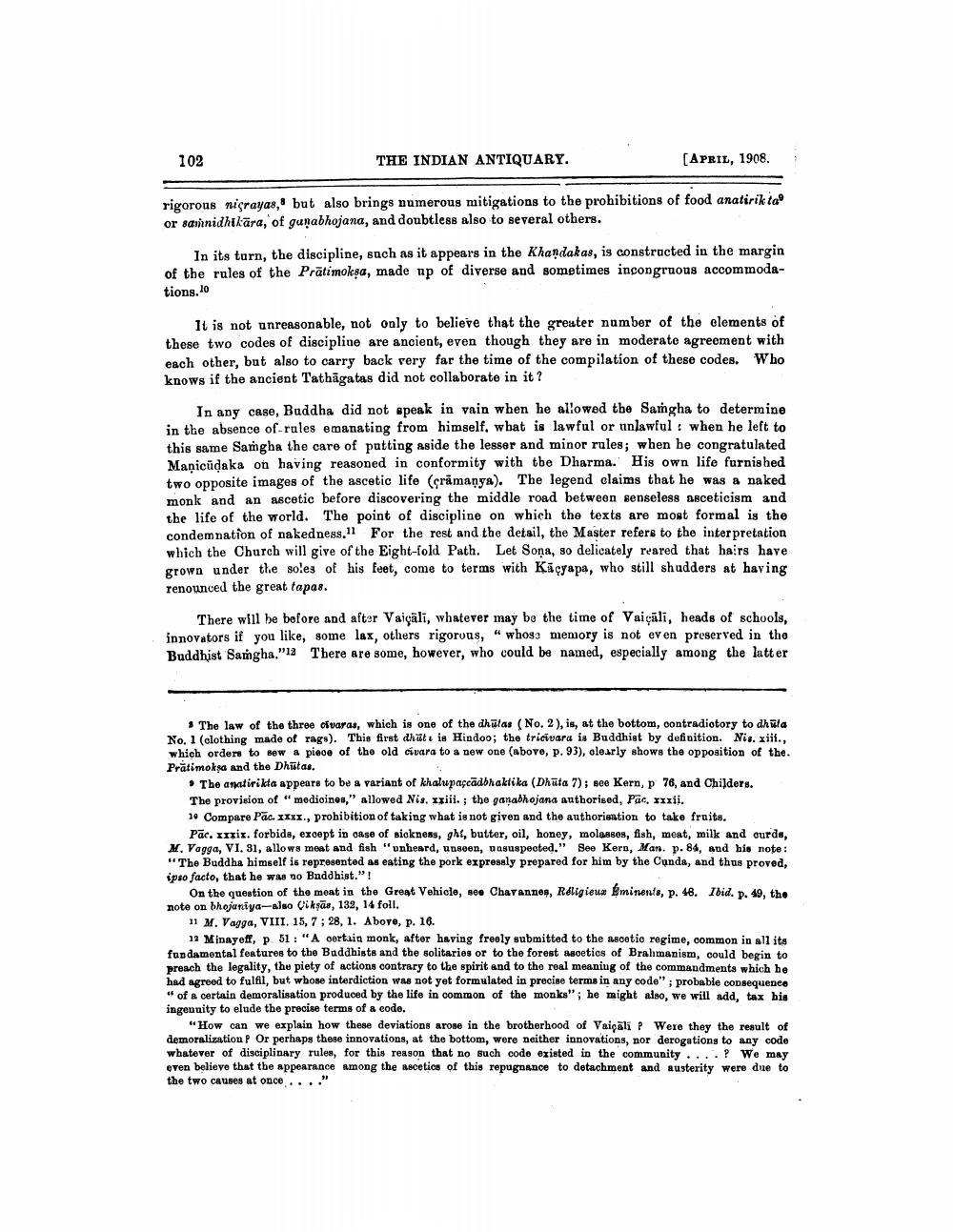________________
102
THE INDIAN ANTIQUARY.
[APRIL, 1908.
rigorous niçrayas, but also brings numerous mitigations to the prohibitions of food anatirik ia or savinidhtkāra, of gunabhojana, and doubtless also to several others.
In its turn, the discipline, such as it appears in the Khandakas, is constructed in the margin of the rules of the Prātimoksa, made up of diverse and sometimes incongruous accommodations.10
It is not unreasonable, not only to believe that the greater number of the elements of these two codes of discipline are ancient, even though they are in moderate agreement with each other, but also to carry back very far the time of the compilation of these codes. Who knows if the ancient Tathāgatas did not collaborate in it?
In any case, Buddha did not speak in vain when he allowed the Samgha to determine in the absence of rules emanating from himself, what is lawful or unlawful when he left to this same Samgha the care of putting aside the lesser and minor rules; when he congratulated Maņicūdaka on having reasoned in conformity with the Dharma. His own life furnished two opposite images of the ascetic life (prāmanya). The legend claims that he was a naked monk and an ascetic before discovering the middle road between senseless asceticism and the life of the world. The point of discipline on which the texts are most formal is the condemnation of nakedness. For the rest and the detail, the Master refers to the interpretation which the Church will give of the Eight-fold Path. Let Soņa, so delicately reared that hairs have grown under the soles of his feet, come to terms with Kāçyapa, who still shudders at having renounced the great tapas.
There will be bofore and after Vaicāli, whatever may be the time of Vaicüli, heads of schools, innovators if you like, some lax, others rigorous," whose memory is not even preserved in the Buddhist Sangha,"12 There are some, however, who could be named, especially among the latter
The law of the three civaras, which is one of the dhūlas (No. 2), is, at the bottom, contradiotory to dhüla No. 1 (clothing made of rage). This first dhüt is Hindoo; the triciuara is Buddhist by definition. Ni.. xiii., which order to sew piece of the old civara to a new one (above, p. 93), ole.rly shows the opposition of the Prātimoksa and the Dhūtas.
The amatirikta appears to be a variant of khalupaccadbhaktika (Dhūta 7); see Kern, p 76, and Childers. The provision of "medicines," allowed Nis. Ixiii. ; the ganabhojana authorised, Pac, rxxii. 10 Compare Pac. IXXX., prohibition of taking what is not given and the authorisation to take fruits.
Pāc. xxxix. forbids, exoept in case of sickness, ghí, butter, oil, honey, molassos, fish, meat, milk and ourds, M. Vagga, VI. 31, allows meat and fish "unheard, unseen, unsuspected." See Kern, Man. p. 84, and his note: "The Buddha himself is represented as eating the pork expressly prepared for him by the Cunda, and thus proved, ipso facto, that he was no Buddhist."!
On the question of the meat in the Great Vehicle, see Chavannes, Religieuw eminents, p. 46. Ibid. p. 49, the note on bhojarīya-also likşās, 132, 14 foll.
11 M. Vagga, VIII. 15,7; 28, 1. Above, p. 16.
11 Minayeff, p. 51: "A certain monk, after having freely submitted to the ascetio regime, common in all its fundamental features to the Buddhists and the solitaries or to the forest soetics of Brahmanism, could begin to preach the legality, the piety of actions contrary to the spirit and to the real meaning of the commandments which he had agreed to fulfil, but whose interdiction was not yet formulated in precise terms in any code"; probable consequeneo " of a certain demoralisation produced by the life in common of the monks", he might also, we will add. tax his ingenuity to elude the precise terms of a code.
How can we explain how these deviations arose in the brotherhood of Vaicāli ? Were they the result of demoralization Or perhaps these innovations, at the bottom, were neither innovations, nor derogations to any code whatever of disciplinary rules, for this reason that no such code existed in the community ....? We may even believe that the appearance among the ascetics of this repugnance to detachment and austerity were due to the two causes at once...."




